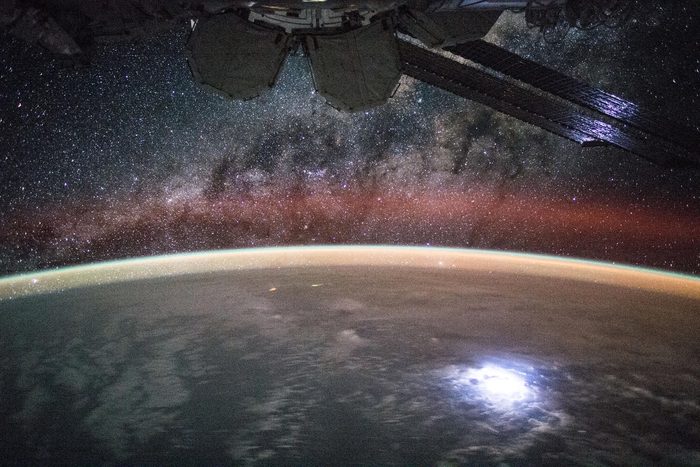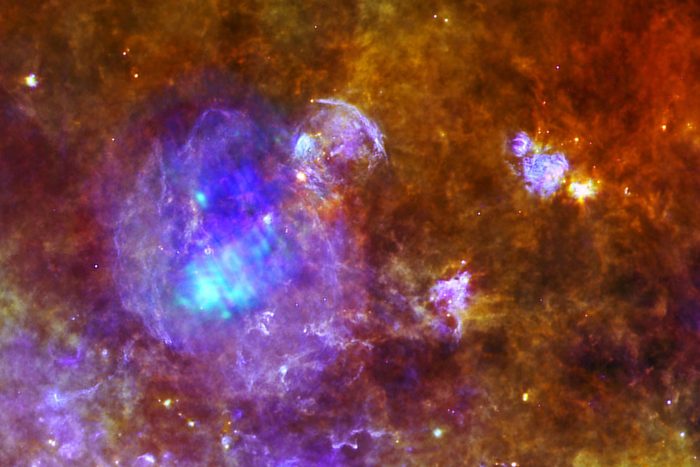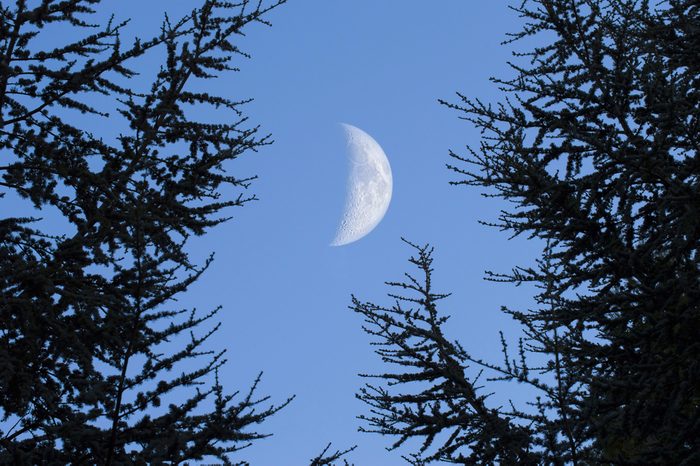From a bar in the clouds to finding more water from the Moon, outer space is constantly surprising us.

23 Astronomy Facts You Never Learned in School


The sun is bigger than you can even imagine
When you look up at the sky and see the sun beaming down at you, it’s hard to tell how truly big it is. So consider this: 1.3 million duplicates of Earth could comfortably fit inside of it, according to NASA. And if the sun didn’t supply our main energy, we’d be shivering in the dark; every 1.5 millionth of a second it releases more energy than is consumed by all humans on earth in an entire year.

There’s a bar in the sky
It may seem like a bartender’s dream (or nightmare), but somewhere in our galaxy, there’s a gas cloud that contains ethyl alcohol and is about 1,000 times the diameter of our entire solar system. There’s enough alcohol for about 400 septillion pints of beer (that’s 400 followed by 24 zeros!)—enough alcohol to supply 300,000 pints of beer to everyone on Earth daily for a billion years. Cheers!

Walking in space might cause you to crave a steak
Astronauts returning from a space walk have noted the aroma of various odors on their space suits ranging from metal to a charcoal-broiled steak. That’s due to polycyclic aromatic hydrocarbons (PAHs), which are by-products of dying stars. PAHs are also released from burning coal, wood, gasoline, and—you guessed it—charcoal-broiled meat.

There’s a lot of trash out there
There may be a lot of garbage filling up our landfills on earth, but there are estimated to be 100 million pieces of trash the size of a pencil tip or larger orbiting the planet, too. Space junk is a real problem and with 30,000 of these objects bigger than a softball, it could wreak havoc on our satellite system—that could mean no Netflix for you, among more serious issues like messing with our national security system. Currently, there’s no great way to clean up space, but scientists are focusing on solutions.

Raspberries have a connection to space
OK, you can’t actually go raspberry picking in space—yet. But, as it turns out, the main component that gives raspberries their distinctive flavor, ethyl formate, was discovered in the Milky Way in 2009. Ethyl formate is also a component of rum, but it’s also unlikely you’ll be able to order a rum and coke in the galaxy any time soon—especially since alcohol is one of the foods that are banned from space.

Uranus is quirky
As the only planet that rotates at a nearly 90-degree angle from the plane of its orbit, this makes Uranus appear to spin on its side, Uranus has scientists baffled. Some theories include that the planet’s orientation may have been altered at some point by a titanic collision with an asteroid or another planet. Another theory posits Uranus once had a moon that gradually nudged the planet onto its side, and then irregularities in the orbits of both objects resulted in a collision obliterating the satellite. Either way, it’s the solar system oddball when it comes to planet rotations. But then, space is weird.

Stargazing is (almost) like looking into the past
Since stars are so far away and their light takes so long to reach Earth, it’s possible the star you’re looking at is already dead. A good example is the Pillars of Creation, which are part of a region called the Eagle Nebula that’s 7000 light-years away from us. These pillar-like clouds of dust and gas were first imaged by the Hubble Telescope in 1995—but they were actually destroyed at least 6,000 years ago, possibly by a blast from a supernova. What we’re seeing in Hubble’s 1995 image is what the Pillars of Creation looked like 7000 years ago. The good news: those “already dead” stars are rare, so the majority of the stars in the sky are still intact, and will be for a few more billion years.

You can lose weight by planet hopping
If you’re, say, 140 pounds, did you know you would be about 53 pounds on Mercury? Without getting caught up in complicated math, the reason behind the swift weight change is the planet’s gravitational field. This is because your mass is constant across the universe, while your weight measurement changes depending on the force of gravity wherever you are—and gravity changes from planet to planet. Since Mercury’s gravitational field is less than Earth’s, you’d weigh less. If the gravitational field is more than the Earth’s, you’d, of course, weigh more.

Pieces of Mars have been discovered on Earth
You don’t have to go all the way to Mars to get a souvenir from the red planet. When meteorites from the Sahara Desert and Antarctica were analyzed, it was revealed that some had come from Mars. However, it is estimated that of the 80,000 known meteorites found on earth, only 400 are of Martian origin, the rest are from the moon, comets or asteroids.

Pluto was downgraded
Pluto was unceremoniously kicked off the team of full-sized planets we consider part of our solar system. (The rest of them are, of course, Mercury, Venus, Earth, Mars, Jupiter, Saturn, Uranus and Neptune.) “The International Astronomical Union reclassified poor Pluto as a dwarf planet in 2006—a move that had astrologers and many a stargazer alike upset at the demotion. Pluto lost its status due to being just half the width of the United States—way smaller than any of the other planets sharing the same status in the solar system—and because of its vastly diminished size and mass, other objects might cross Pluto’s orbital path.

The solar system moves really slowly
The last time our solar system was in its current position around the Milky Way, the earliest dinosaurs were first roaming the Earth. That’s because it takes a whopping 230 million years for our solar system to complete one single orbit around the Milky Way. That really puts that long-day feeling into perspective.

Earth is slowing down
Four hundred million years ago, a day was only 22 hours long. These extra two hours to sleep (or read fun facts online) is due to the gradual slowing of the Earth’s rotation. The distance between Earth and the Moon is slowly increasing and the gravitational forces affecting our planet, visible as ocean tides, become weaker. As the Moon drifts away from Earth, our rotation speed decreases, and the day lengthens. Hey, we all slow down a bit as we age, right?

The moon creates an optical illusion
The sun and moon look nearly similar in size when seen from earth, but don’t let your eyes fool you. Not only does the sun actually dwarf the moon in size—it’s 400 times larger—it’s also 400 times further away from Earth than the moon. This incredibly rare set of parallel circumstances gives the sun the illusion of appearing moon-size and also lets us observe amazing coronal displays and prominences during total solar eclipses.

The moon can be visible in the daytime
Depending on the moon’s position above the horizon and how it coincides with the sun’s position, you should be able to see the moon during the daytime. In fact, it’s actually pretty common—the only time you wouldn’t be able to see the moon is when it’s a “new” moon, meaning the lit side of the moon is facing away from the Earth—or if there are clouds, but you knew that!

Solar system maps are wrong
If a map of the solar system was created to scale, it would be way too big to hang. Using a single pixel to represent the moon, designer and developer Josh Worth created what he calls “a tediously accurate scale model of the solar system.” You’re probably better off going with the textbook version that makes the planets appear a wee bit closer if you want something to hang on your wall.

Polaris isn’t here to stay
Polaris, our North Star, isn’t leaving us anytime soon—at least not for another 12,000 years. But when it does, the star Vega will replace it. Why? It’s all about the rotation of the Earth. As our planet’s axis changes over a very long 26,000-year cycle, the north eventually shifts to different stars. It won’t be the first time Vega gets the starring role in our night sky; it was the North Star 14,000 years ago.

Peace and quiet are out of this world
If you need some time to chill out and ditch all the noise on Earth, you might want to go for a spacewalk. That’s because we can’t hear sound in space. Sound travels by making molecules vibrate, but in space, there are only five particles (mostly hydrogen atoms) in the same volume (a square centimeter of air) that you would find 100,000,000,000,000,000,000 molecules here on Earth. According to Cosmos magazine, you would need “an eardrum comparable to the size of Earth” to hear the small pressure variations of the electromagnetic waves that you’d find in space. Oh, and that’s in the space near us. The density decreases the farther from the Sun you go, and between stars there are just 0.1 particles per cubic centimeter.

Black holes belch stars
A black hole can actually suck up a star and burp it back out. Sound gross? When a star gets pulled into a black hole, it will release a huge jet of gas. This “burp” can span hundreds of light-years. “When the star is ripped apart by the gravitational forces of the black hole, some part of the star’s remains falls into the black hole, while the rest is ejected at high speeds,” notes Suvi Gezari, a researcher at Johns Hopkins University.

Mars is a bit rusty
Although there isn’t any water on Mars, it’s rusty red on its surface and so is its sky. Earth rust is made from iron and water, and one theory about the iron oxide on Mars is that it probably formed many eons ago, when there may have been water on the planet (there’s still ice at its north and south polar caps, although it’s primarily made of carbon dioxide). The planet remains very rich in iron oxide.

Gravity also affects your tears
Whether it’s tears or plain old water, the weightless atmosphere in space causes liquid to adhere to a surface rather than fall. When it comes to tears, they’ll just cling to your face and and form puddles around your eyes, so you’ll look like an alien. Fitting!

Keep those socks on in space
Astronauts don’t spend a lot of time on their feet while they’re floating around in the weightless environment of space, but just like on earth they enjoy being warm and comfy. This might give their tootsies a nice break, but it also causes the skin on their feet to soften and flake. Astronauts don’t change their underwear and socks frequently as they can’t do laundry like at home. So when socks are removed sloughed-off skin can be released and end up floating about. Gross! Luckily, there are air filters on board to remove the detritus.

Venus runs hot and cold
A planet with a reputation for an atmosphere five times hotter than boiling water, Venus has a cold spot, too. Although the average temp is hot, hot, hot, there’s a cold layer hidden in its atmosphere with temperatures of -175 °C and possibly carbon dioxide ice. “The cold layer is unique, in that Earth and Mars don’t have anything like it,” said Håkan Svedhem, ESA’s Venus Express project scientist, in a press release.

Moon water might one day be a thing
A NASA research project has found that the moon might one day be a space resource for water, as it contains a lot more H2O than previously thought. Scientists surmise we could extract water from pyroclastic deposits, a substance on the moon made mostly of volcanic glass beads formed during ancient explosive eruptions.
Why trust us
At Reader’s Digest, we’re committed to producing high-quality content by writers with expertise and experience in their field in consultation with relevant, qualified experts. We rely on reputable primary sources, including government and professional organizations and academic institutions as well as our writers’ personal experiences where appropriate. We verify all facts and data, back them with credible sourcing and revisit them over time to ensure they remain accurate and up to date. Read more about our team, our contributors and our editorial policies.
Sources:
- NASA. “Where Does the Sun’s Energy Come From?”
- New York Times. “Alcohol-Laden Cloud Holds the Story of a Star”
- The Guardian. “Galaxy’s centre tastes of raspberries and smells of rum, say astronomers”
- Astronomy. “Astronomers have a new theory for why Uranus spins on its side”
- Natural History Museum of London. “Martian meteorites: Rare visitors from the red planet”
- NASA. “Pluto”
- NASA. “Solar System Facts”
- Astronomy. “Why is the Moon exactly the same apparent size from Earth as the Sun?”
- Cosmos Magazine. “Explainer: Is there sound in space?”
- Jet Propulsion Lab. “Black Hole Caught Red-Handed in a Stellar Homicide”
- NASA. “Researchers Catch Supermassive Black Hole Burping – Twice”
- National Geographic. “Tears of an Astronaut”
- National Air and Space Museum. “Socks, Slipper, Space Shuttle”
- European Space Agency. “A curious cold layer in the atmosphere of Venus”
- NASA. “NASA’s SOFIA Discovers Water on Sunlit Surface of Moon”




















